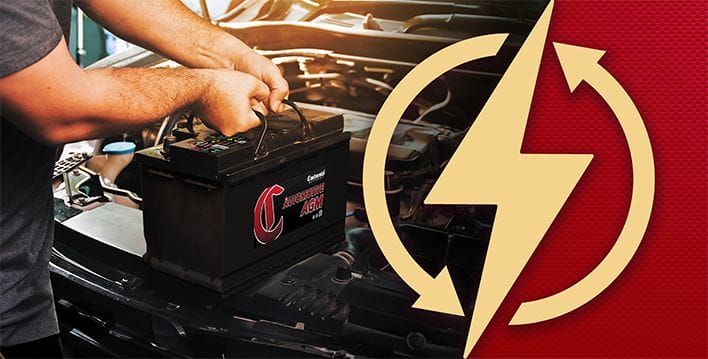
Golf carts are essential for lugging clubs and other equipment across a vast course, but they can also be useful in many other applications. They’re useful for getting around big properties, like a college campus or wedding venue, and for some users, they’re just downright fun to travel around in.
But what happens when the golf cart doesn’t seem to have the power it once had? Maybe you’re spending more time charging up the golf cart or you can only travel a fraction of what you once could before the golf cart runs out of power.
There are many signs to look for when the golf cart battery is on its way out, and it’s helpful to know the signs that it’s time to replace it.
In this article, you’ll learn about:
- The lifespan of a golf cart battery
- Different types of golf cart batteries (and their applications)
- Signs it’s time to replace your golf cart battery
- Maintaining golf cart batteries to maximize their lifespan
How Long Do Golf Cart Batteries Last?
The lifespan of a golf cart battery depends on a number of factors, including the type of battery, how frequently the golf cart is used and charged, and how the battery is maintained and cared for over time.
Lead-acid golf cart batteries last about two to five years with regular use, while lithium-ion golf cart batteries may last ten to 20 years with proper maintenance. Golf carts that belong to an individual person or household tend to last longer, about six to ten years, compared to fleet vehicles that are used by multiple people throughout the day. These fleet vehicles can get about four to six years out of the battery before it needs to be replaced.
Types of Golf Cart Batteries
There are many types of golf cart batteries, and each has its pros and cons. You can find 6-volt golf cart batteries, 8-volt golf cart batteries or 12-volt golf cart batteries to provide the 36- or 48-volt system. Run time is typically improved with 6-volt golf cart batteries, but you’ll need more of them to meet the golf cart’s needs, which can increase the weight and make installation more difficult.
In addition to finding the right power capacity, you can choose from different types of golf cart batteries, such as lead-acid, absorbed glass mat (AGM), gel lead-acid or lithium-ion batteries. These batteries have different benefits, with some performing better in extreme weather while others provide a longer lifespan.
Lead-Acid Golf Cart Batteries
Lead-acid batteries are one of the most common battery types for golf carts. These traditional batteries have the benefit of being the most affordable option and are easy to maintain. But they tend to have a shorter lifespan than more advanced golf cart battery types, typically lasting only about two to five years. Lead-acid golf cart batteries are also heavy, not an ideal trait in such a small vehicle.
Absorbed Glass Mat (AGM) Golf Cart Batteries
AGM batteries have absorbable electrolyte and fiberglass plates within the battery that allow the battery to charge up to five times faster than a conventional lead-acid battery and protect against leaks, which can corrode and shorten the battery lifespan.
These batteries require little maintenance and may last up to six or seven years. One drawback is that they’re a more expensive option, which can really add up in costs when you’re servicing a fleet of golf carts.
Gel Lead-Acid Golf Cart Batteries
True to its name, a gel lead-acid battery uses a gel to suspend the electrolyte within the battery. Electrons can flow through the gel from plate to plate, providing leak-proof protection and minimal maintenance. This design also helps this type of golf cart battery power through extreme temperatures, particularly cold weather that can shorten the lifespan of most golf cart batteries. These batteries don’t offer the quick charging of AGMs, though.
Lithium-Ion Golf Cart Batteries
Small and lightweight, lithium-ion golf cart batteries are a more expensive upfront investment but can offer better savings in the long run. These batteries are known for lasting a long time, usually over 10 years and as many as 20 years with proper care.
Lithium-ion batteries require little maintenance since you don’t need to add water. Self-discharging can be an issue with other golf cart batteries, but lithium-ion batteries have a low self-discharge rate that allows them to sit for longer periods of time without becoming drained of power.
5 Signs a Golf Cart Battery Needs to be Replaced
Suspect a failing battery? Check for these signs that you need a golf cart battery replacement before you’re left with a completely dead battery.
- Slow Charging Times
Over time, your golf cart batteries will likely take longer and longer to charge. You could notice the battery taking anywhere from a couple of extra hours to recharge compared to normal or an entire day before it’s ready to go back onto the course. If your battery is taking longer than 8 to 10 hours to recharge, it is likely nearing the end of its lifespan.
- Poor Acceleration
When you press down on the gas pedal, you expect the golf cart to start moving. If the golf cart is struggling to pick up speed when you push down on the gas, it could be a sign of an aging battery. You may also notice the golf cart has an even more difficult time than usual getting up and over hills.
- Shorter Distances Traveled
Your golf cart used to travel several miles in a day before it needed to be recharged. Now, it can only go a mile or two before losing power or the golf cart battery lasts for way less time between charges. This is another indicator that you need a golf cart battery replacement. The golf cart battery should be strong enough to at least get around a golf course for a few rounds of golf.
- Leaks
You drive the golf cart away from the storage area but notice it has left a puddle behind. This could be a sign of a battery leak in lead-acid batteries. Lead-acid batteries can leave behind toxic chemicals that are harmful to you, your property and the environment. If you notice a leaking battery, it’s important to clean up the leak and replace the battery as soon as possible to prevent further damage.
- Visible Battery Damage
Aside from a leaking battery, there are many other visible signs of a damaged battery. Batteries may have corrosion or could crack or bulge. Corrosion can cause further and more expensive damage, like causing terminals to release or causing the battery casing to crack.
Recharging the batteries can generate heat, which, over time, causes the batteries to bulge. Visible damage, including corrosion, cracks or bulges are common indicators of an old, worn-out battery.
Golf Cart Battery Maintenance
Whether you power your golf carts with lead-acid batteries, AGMs, gel lead batteries or lithium-ion batteries, the equipment is only as good as the attention and care you give it. A little TLC can be the difference between a golf cart battery that only lasts a few years versus a battery that lasts nearly a decade.
Charge Properly
When it’s time to recharge the golf cart fleet, make sure to only charge the batteries for about 8 to 10 hours at a time. Overcharging can damage the battery cells and could dry out the battery, meaning you need to refill the water more often. Only charge until the battery is full rather than leaving the golf cart charging all the time when it isn’t in use.
Don’t Let Batteries Die
While you don’t want to overcharge your golf cart batteries, you also want to avoid letting the batteries die too. Ideally, you want to keep the batteries at least halfway charged and no lower than 20% charged. The optimal charging limits will be provided by the battery manufacturer, so follow those instructions closely to prolong the life of your battery.
Store Carts in a Warm Place
Aside from gel batteries, most golf cart batteries don’t stand up well to cold weather. Cold temperatures can drain the battery. Store the carts in a warm garage or other storage space, and try to avoid driving them in extreme temperatures. You can use a trickle charger during colder months to keep the battery charged without overcharging it.
Minimize Strain on the Battery
While it might be fun to ride golf carts up and over big hills on the course or around the property, stick to straight, flat pathways whenever possible. Going up hills requires more power from the battery, and doing this frequently can wear down the battery sooner.
Inspect Batteries Regularly
If you want your batteries to last longer, regular inspections will help you catch any problems early. First, you’ll want to check lead-acid batteries once per month and keep the water at the fill line. For batteries that don’t need water, inspect the batteries for visible damage and test the voltage about once every couple of months.
Find the Right Golf Cart Batteries For Your Needs
A golf cart battery’s lifespan depends on many factors, but you can help it last longer with regular maintenance and by finding the best battery to meet your needs — whether you need to power up a couple of golf carts or a huge fleet.






